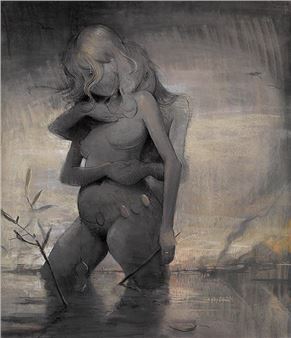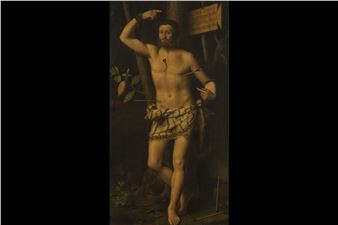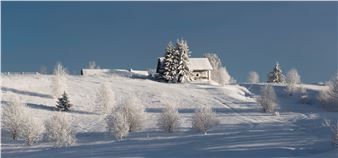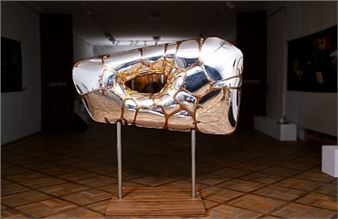Adrian Ghenie: I have turned my only faceвҖҰ
The display will contain 12 paintings, including ones that were created under the impression of the reproductions of pictures in the Hermitage that the artist used to look at in his childhood. For Ghenie national identity (the title of the exhibition includes a quotation from a poem by Nichita StДғnescu, RomaniaвҖҷs national poet who was nominated for a Nobel Prize) and profoundly personal biographical elements (life in the period of вҖңstagnationвҖқ; childhood emotions aroused by his parentsвҖҷ stories of Eastern Bloc countries) form two pillars of his art.
Adrian Ghenie was born in 1977, in the Romanian city of Baia Mare, at the tail-end of the CeauИҷescu regime. He graduated from the Art and Design University of Cluj-Napoca and now lives between Berlin and Cluj. In the 2010s, GhenieвҖҷs career rapidly took off: he turned from a regular member of the Romanian art scene into a figure in high demand at the international level, both by the art market and the museum community. GhenieвҖҷs works can be found in prestigious art collections around the world, including Tate Modern, London, the Pompidou Centre, Paris and the San Francisco Museum of Modern Art. In 2015, the artist represented Romania at the Venice Biennale.
The uniqueness of GhenieвҖҷs story lies in his early connection with the Hermitage. At a young age, he was given an album of Dutch paintings produced by В«IskusstvoВ» Publishing House, 1984, and it became his chief source of inspiration for a long time. Over many years, the future artist copied step-by-step the reproductions of the masterpieces in the Saint Petersburg museum, eventually arriving at his own artistic style.
GhenieвҖҷs works are marked by a combination of blurred, rough textures and inclusions of light and colour that are at times shapeless, but elsewhere sharply outlined with the precise, almost photographic definition of individual elements. This play of contrasts produces a collage-like impression and adds additional depth: GhenieвҖҷs unique style can be described as hybrid, dynamic and cinematic. The artist rejects the use of the brush, preferring the palette knife and spatulas. A restrained colour scheme is disrupted by chromatic explosions that scintillate like a glitch in a digital image or patches of oil on water. This combination of the chaotic and the orderly affects the viewer on an almost physiological level: GhenieвҖҷs painting aims at a sensual, intuitive perception.
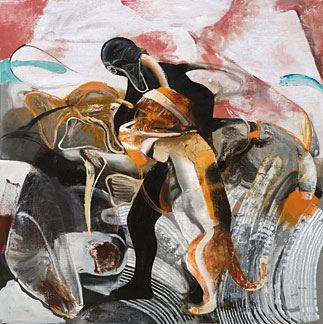
Recommended for you
The display will contain 12 paintings, including ones that were created under the impression of the reproductions of pictures in the Hermitage that the artist used to look at in his childhood. For Ghenie national identity (the title of the exhibition includes a quotation from a poem by Nichita StДғnescu, RomaniaвҖҷs national poet who was nominated for a Nobel Prize) and profoundly personal biographical elements (life in the period of вҖңstagnationвҖқ; childhood emotions aroused by his parentsвҖҷ stories of Eastern Bloc countries) form two pillars of his art.
Adrian Ghenie was born in 1977, in the Romanian city of Baia Mare, at the tail-end of the CeauИҷescu regime. He graduated from the Art and Design University of Cluj-Napoca and now lives between Berlin and Cluj. In the 2010s, GhenieвҖҷs career rapidly took off: he turned from a regular member of the Romanian art scene into a figure in high demand at the international level, both by the art market and the museum community. GhenieвҖҷs works can be found in prestigious art collections around the world, including Tate Modern, London, the Pompidou Centre, Paris and the San Francisco Museum of Modern Art. In 2015, the artist represented Romania at the Venice Biennale.
The uniqueness of GhenieвҖҷs story lies in his early connection with the Hermitage. At a young age, he was given an album of Dutch paintings produced by В«IskusstvoВ» Publishing House, 1984, and it became his chief source of inspiration for a long time. Over many years, the future artist copied step-by-step the reproductions of the masterpieces in the Saint Petersburg museum, eventually arriving at his own artistic style.
GhenieвҖҷs works are marked by a combination of blurred, rough textures and inclusions of light and colour that are at times shapeless, but elsewhere sharply outlined with the precise, almost photographic definition of individual elements. This play of contrasts produces a collage-like impression and adds additional depth: GhenieвҖҷs unique style can be described as hybrid, dynamic and cinematic. The artist rejects the use of the brush, preferring the palette knife and spatulas. A restrained colour scheme is disrupted by chromatic explosions that scintillate like a glitch in a digital image or patches of oil on water. This combination of the chaotic and the orderly affects the viewer on an almost physiological level: GhenieвҖҷs painting aims at a sensual, intuitive perception.
Artists on show
Contact details


 ARTISTS
ARTISTS











